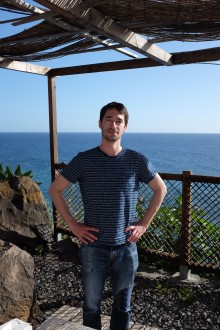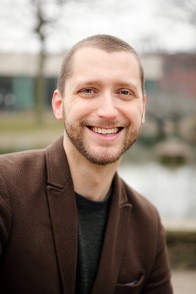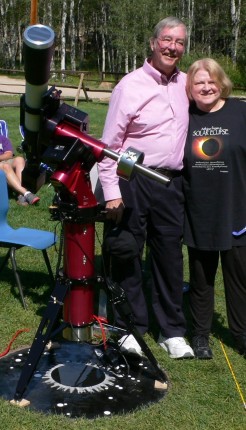by The Holometer Team: Aaron Chou, Henry Glass, H Richard Gustafson, Craig Hogan, Brittany L Kamai, Ohkyung Kwon, Robert Lanza, Lee McCuller, Stephan S Meyer, Jonathan Richardson, Chris Stoughton, Ray Tomlin and Rainer Weiss.
In a patch of prairie west of Chicago, amidst the rusting relics of 20th century particle beam experiments, we’ve built a new kind of device, designed to monitor positions of isolated, stationary massive bodies—or more precisely, to measure their spacelike correlations in time—with unprecedented fidelity and precision. Why?

The Holometer Team
Fermi National Accelerator Laboratory: Aaron Chou (Co-PI, project manager), Henry Glass, Craig Hogan (Project Scientist), Chris Stoughton and Ray Tomlin. Massachusetts Institute of Technology: Rainer Weiss University of Chicago: Brittany L.Kamai,Ohkyung Kwon, Robert Lanza, Lee McCuller Stephan S Meyer (Co-PI) and Jonathan Richardson
University of Michigan: H. Richard Gustafson
The motivation for our experiment starts with a foundational conflict of the two great pillars of physics, relativity and quantum mechanics. In relativity, space-time is built out of a continuum of events with definite locations in space and time, and it is based on a principle of invariance, that no measurable physical effect can depend on an arbitrary choice of coordinates. Somehow, that classical world shares dynamical energy and information with quantum mechanical systems built out of a set of states that may be discrete, that are in general indeterminate superpositions of different possibilities not localized in space or time, and that only have physical meaning when correlated, in the context of a specific measurement, with the apparatus of an observer. Physicists have tried to reconcile these incompatible ideas for a century, starting with famous dialogs between the founding fathers, Einstein and Bohr.
In practice, the conflict has remained theoretical, since it has not led to any problem predicting the results of actual experiments. But that success is itself a problem: there are no experiments that could give us clues to general principles that may govern a deeper level of reality where a space-time grows out of a quantum system.
Indeed, experiments today solidly confirm both relativity and quantum physics. Energy transformations of dynamical space-time were spectacularly displayed by the recent detection of gravitational waves from black hole binary inspiral and coalescence. Delocalized quantum states of particles appear in modern experiments in the form of real-life spooky spacelike correlations that directly challenge Einstein’s notions of reality and locality.

The Fermilab Holometer under construction
Still, no experiment has measured a quantum behavior of space-time itself. The reason often cited is that the scale where quantum dynamics overwhelms classical space-time, the Planck time, about 10-43 seconds, lies far beyond the reach of direct metrology. However, if quantum states are truly delocalized, it may be possible to reach Planck-scale precision in measurements of correlations in space-time position over a macroscopic volume. The Fermilab Holometer, as we’ve called our machine, is designed to test for such exotic correlations, providing an experimental window into the principles and symmetries of the quantum system that gives rise to space and time.
Theory has provided some important clues that quantum geometry may produce significant exotic correlations in space-time position even on macroscopic scales. Hints from several directions suggest that the amount of quantum information in a volume of space-time of any size—the number of degrees of freedom—is finite and holographic, given by the area of a two-dimensional bounding surface in Planck units. The theory of black hole evaporation also suggests that quantum states of geometry are not themselves localized in space and time, but are distributed over a volume as large as the event horizon or curvature radius.
Such results raise the possibility that a laboratory-scale experiment, with enough sensitivity and the right configuration, could measure new spacelike correlations from Planck-scale quantum geometry. When studying correlations in space-time position, it may not be necessary to resolve a Planck time directly in the time domain. Instead, extrapolations of standard quantum theory suggest that Planck-scale effects should appear in the “strain noise power spectral density”: a mean square dimensionless strain, or fractional length distortion, per frequency interval.
The Holometer resembles a scaled-down version of LIGO (see our instrumentation paper in CQG, http://iopscience.iop.org/article/10.1088/1361-6382/aa5e5c). It consists of two Michelson interferometers with 40-meter arms, located right next to each other, whose signals are correlated in real time. The data acquisition system operates fast enough to keep track of positions across the 40-meter device in both space and time. We’ve shown that we can measure spacelike correlations to a precision of attometers, with a bandwidth of more than 10 MHz—several times faster than the time it takes the laser light to traverse the apparatus. That sensitivity allows us to measure exotic correlations with strain noise power spectral densities substantially less than a Planck time.

An aerial view showing the layout of both the First and Second-Generation Holometers
Over the course of hundreds of hours, light traverses the apparatus about a trillion times, and the instrument measures self-interference from about 1028 photons, allowing a measurement of strain noise density, limited mainly by quantum statistical noise, about 28 orders of magnitude smaller than the period of the laser light. So far, measurements are consistent with zero exotic noise from the space-time itself to much better than Planck precision. This clean null result, reported in https://doi.org/10.110/PhysRevLett.117.111102, verifies the power of the technique. Along the way, it also places unique constraints on gravitational waves at megahertz frequencies not reachable by LIGO; see http://journals.aps.org/prd/abstract/10.1103/PhysRevD.95.063002.
The physical significance of the null result for quantum geometry can be interpreted in terms of models based on symmetries at the Planck scale. Like the famous Michelson-Morley experiment that demonstrated a frame-independent speed of light long before relativity was discovered, it verifies an exact symmetry. Some day, that symmetry may be understood as a consequence of more fundamental principles of the quantum system that underlies space-time.
The null result has already inspired our next experiment, which will measure a different symmetry at similar sensitivity. During the last year, we have changed the physical layout of the interferometer light paths to include a bend and a transverse segment, so that it can now detect correlated rotational fluctuations. The reconfigured apparatus will allow us to measure fluctuations in rotation of the local inertial frame that correspond to mean square variations in angular direction per frequency interval less than a Planck time. Rotational fluctuations of this magnitude, with a specific frequency spectrum (see the calculations in arXiv:1607.03048, arXiv:1509.07997), would be expected if the local inertial frame emerges from a quantum system at the Planck scale.
[1] Chou, A.S., Gustafson, R., Hogan, C., Kamai, B., Kwon, O., Lanza, R., McCuller, L., Meyer, S.S., Richardson, J., Stoughton, C. and Tomlin, R., 2016. First measurements of high frequency cross-spectra from a pair of large Michelson interferometers. Physical Review Letters, 117, p.111102. https://doi.org/10.110/PhysRevLett.117.111102
[2] Chou, A.S., Gustafson, R., Hogan, C., Kamai, B., Lanza, R., Larson, S.L., McCuller, L., Meyer, S.S., Richardson, J., Stoughton, C. and Tomlin, R., 2016. MHz Gravitational Wave Constraints with Decameter Michelson Interferometers. Physical Review D, 95, 063002. http://journals.aps.org/prd/abstract/10.1103/PhysRevD.95.063002
[3] Hogan, C., Kwon, O. and Richardson, J., 2016. Statistical Model of Exotic Rotational Correlations in Emergent Space-Time. arXiv preprint arXiv:1607.03048. arXiv: 1607.03048
[4] Hogan, C., 2015. Exotic Rotational Correlations in Quantum Geometry. arXiv preprint arXiv:1509.07997. arXiv: 1509.07997
Read the full article in Classical and Quantum Gravity:
The Holometer: an instrument to probe Planckian quantum geometry
Aaron Chou et al. 2017 Class. Quantum Grav. 34 065005
Sign up to follow CQG+ by entering your email address in the ‘follow’ box at the foot of this page for instant notification of new entries.
CQG papers are selected for promotion based on the content of the referee reports. The papers you read about on CQG+ have been rated ‘high quality’ by your peers.
This work is licensed under a Creative Commons Attribution 3.0 Unported License.
Tell your friends about CQG+














You must be logged in to post a comment.